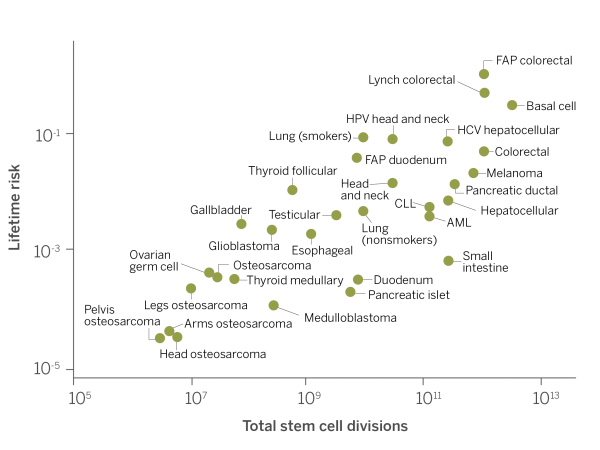Why? That’s the first word on many lips after a cancer diagnosis. “It’s a perfectly reasonable question,” says Bert Vogelstein, a cancer geneticist at Johns Hopkins University in Baltimore, Maryland, who has spent a lifetime trying to answer it. Thanks to his friendship with a recently minted Ph.D. in applied mathematics, the two now propose a framework arguing that most cancer cases are the result of biological bad luck.
In a paper this week in Science, Vogelstein and Cristian Tomasetti, who joined the biostatistics department at Hopkins in 2013, put forth a mathematical formula to explain the genesis of cancer. Here’s how it works: Take the number of cells in an organ, identify what percentage of them are long-lived stem cells, and determine how many times the stem cells divide. With every division, there’s a risk of a cancer-causing mutation in a daughter cell. Thus, Tomasetti and Vogelstein reasoned, the tissues that host the greatest number of stem cell divisions are those most vulnerable to cancer. When Tomasetti crunched the numbers and compared them with actual cancer statistics, he concluded that this theory explained two-thirds of all cancers.
“Using the mathematics of evolution, you can really develop an engineerlike understanding of the disease,” says Martin Nowak, who studies mathematics and biology at Harvard University and has worked with Tomasetti and Vogelstein. “It’s a baseline risk of being an animal that has cells that need to divide.”
The idea emerged during one of the pair’s weekly brainstorming sessions in Vogelstein’s office. They returned to an age-old question: How much of cancer is driven by environmental factors, and how much by genetics? To solve that, Tomasetti reasoned, “I first need to understand how much is by chance and take that out of the picture.”
By “chance” Tomasetti meant the roll of the dice that each cell division represents, leaving aside the influence of deleterious genes or environmental factors such as smoking or exposure to radiation. He was most interested in stem cells because they endure—meaning that a mutation in a stem cell is more likely to cause problems than a mutation in a cell that dies more quickly.
Tomasetti searched the literature to find the numbers he needed, such as the size of the stem cell “compartment” in each tissue. Plotting the total number of stem cell divisions over a lifetime against the lifetime risk of cancer in 31 different organs revealed a correlation. As the number of divisions rose, so did risk.
Colon cancer, for example, is far more common than cancer of the duodenum, the first stretch of the small intestine. This is true even in those who carry a mutated gene that puts their entire intestine at risk. Tomasetti found that there are about 1012 stem cell divisions in the colon over a lifetime, compared with 1010 in the duodenum. Mice, by contrast, have more stem cell divisions in their small intestine—and more cancers—than in their colon.
The line between mutations and cancer isn’t necessarily direct. “It may not just be whether a mutation occurs,” says Bruce Ponder, a longtime cancer researcher at the University of Cambridge in the United Kingdom. “There may be other factors in the tissue that determine whether the mutation is retained” and whether it triggers a malignancy.
That said, the theory remains “an extremely attractive idea,” says Hans Clevers, a stem cell and cancer biologist at the Hubrecht Institute in Utrecht, the Netherlands. Still, he points out, the result “hinges entirely on how good the input data are.”
Tomasetti was aware that some of the published data may not be correct. In 10,000 runs of his model, he skewed where various points on the graph were plotted. Always, “the result was still significant,” he says, suggesting the big picture holds even if some of the data points do not. In mathematical jargon, the graph showed a correlation of 0.81. (A correlation of 1 means that by knowing the variable on the x-axis—in this case, the lifetime number of stem cell divisions—one can predict the y-axis value 100% of the time.) Squaring that 0.81 gives 0.65—an indicator of how much of the variation in cancer risk in a tissue is explained by variation in stem cell divisions (see graph above).
For Vogelstein, one major message is that cancer often cannot be prevented, and more resources should be funneled into catching it in its infancy. “These cancers are going to keep on coming,” he says.
Douglas Lowy, a deputy director of the National Cancer Institute in Bethesda, Maryland, agrees, but also stresses that a great deal of “cancer is preventable” and efforts to avert the disease must continue.
Although the randomness of cancer might be frightening, those in the field see a positive side, too. The new framework stresses that “the average cancer patient … is just unlucky,” Clevers says. “It helps cancer patients to know” that the disease is not their fault.
Source: AAAS


